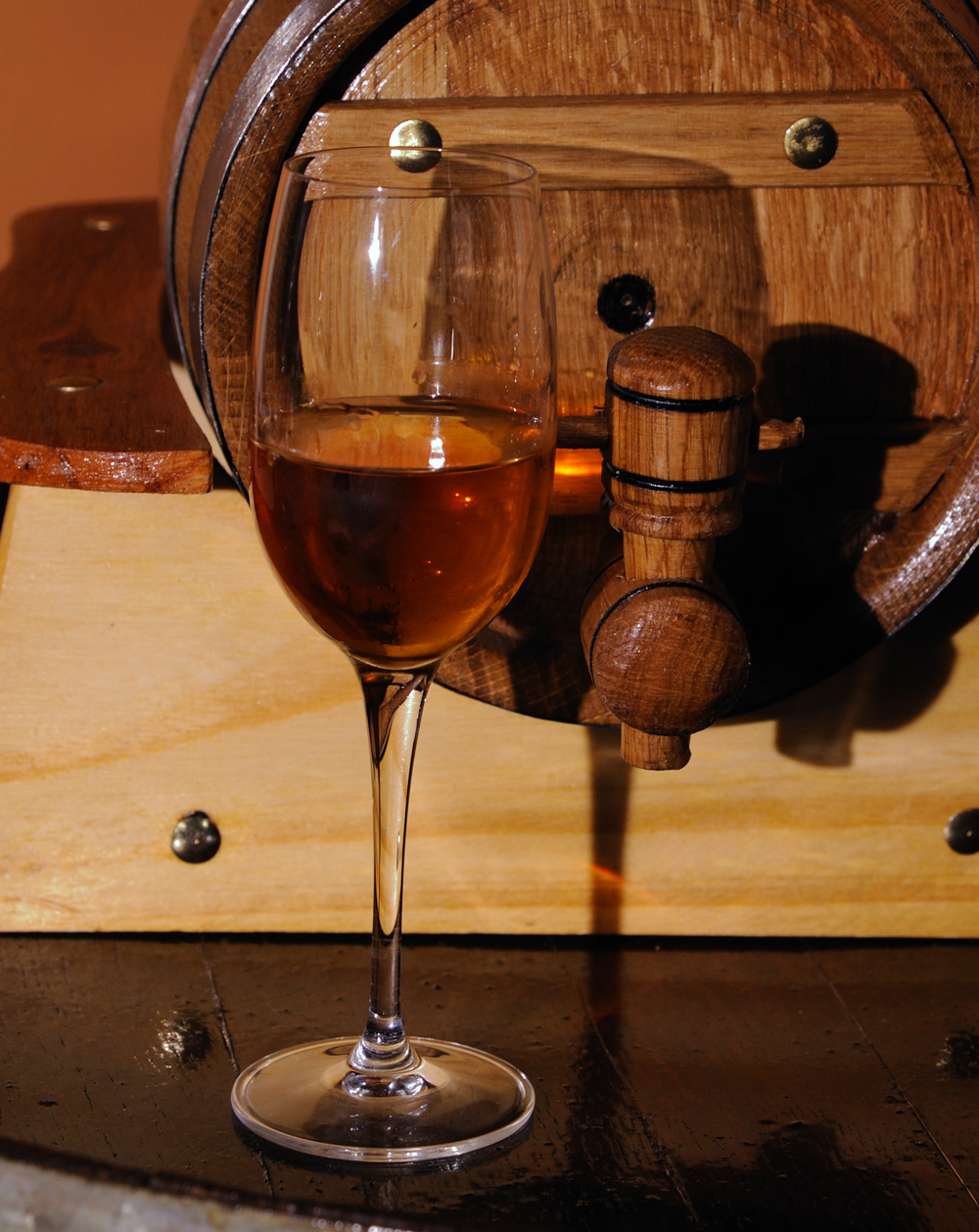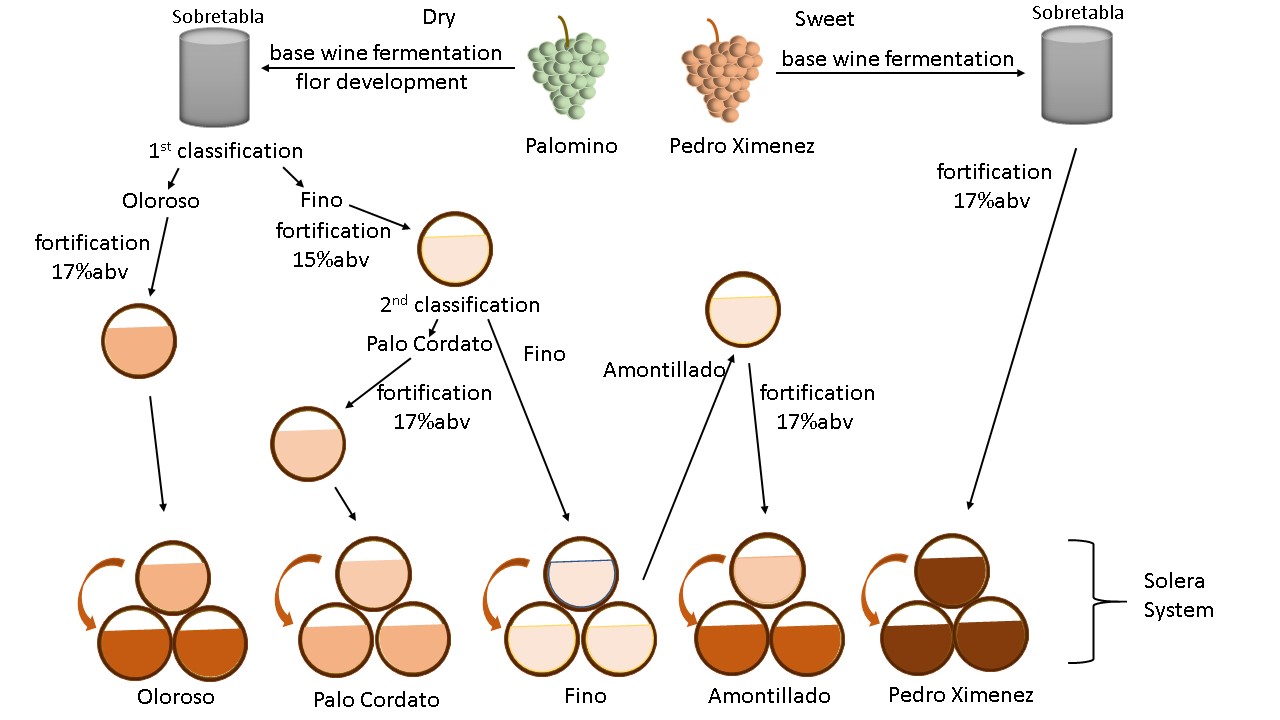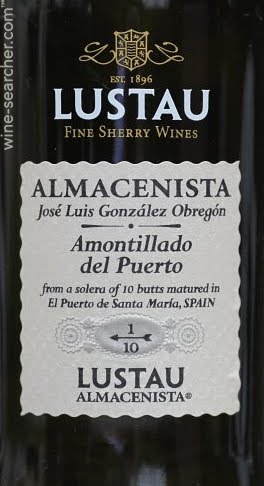
The best accompaniment for this article is a glass of good sherry. So, pure yourself some Amontillado or Oloroso and continue.
Do you realize that the same wine that you are enjoying right now some Englishman enjoyed a hundred years ago? Literally the same. And it didn’t cost you an enormous amount of money. Well, not every drop is the same, but some of them are.
Fortified wines
What is fortified wine? It is traditionally fermented still wine in which ethanol was added after or during fermentation. Ethanol in high concentration kills yeast and, accordingly, stops fermentation. If ethanol was added during fermentation wine would be sweet. Port, Madeira and Vin du Naturel are made in this way. If ethanol was added when fermentation was completed, wine can be dry or sweet depending on the natural sweetness of the base wine. Jerez is made in this way. Pure grape spirit is normally used for fortification. Final alcohol content usually 15-22% abv. After fortification wine is aged for maturation and taste settle. This is the base scheme. Variation of this scheme gives us wide spectre of tastes from Port to dry Jerez.
Winemakers started wine fortification to preserve wine at the shipment from Spain and Portuguese to England. At those days wine was transported in barrels by sea and a journey took many days. Conditions of the journey also were not pleasant for wine. Wine is a delicate substance and long jolting and temperature drops don’t improve its taste. High alcohol and high sugar level improve wine stability, so winemakers started to fortify their wines. Finally the way of preservation transformed into new products with unusual interesting tastes. By the way, the constant tightness between England and France gave o lot of profits to winemaking development at all and to winemaking development in Spain and Portugal particularly.
This article is devoted to the Jerez, the only wine that fortified when base fermentation is completed.
Jerez is produced in the Jerez region of Andalusia on the south of Spain.
By the way, Jerez is classified as PDO wine (read about European Geographical identification system here), so, according to the law, only wine produced by specific technology in the Jerez province can be named Jerez or Xerez or Sherry.

You can find American fortified wine called American Sherry or Californian Sherry. It is not Shery not only by place of production but also by technology. Don’t try to find the taste of Jerez drinking this wine.
Jerez region is famous for its hot and dry climate and chalk soils that provide perfect drainage. This terroir gives grape high sugar content and specific taste.
Three grape varieties are allowed for Jerez production: Palomino, Pedro Ximenez (PX) and Muscat of Alexandria. Palomino is mainly used for dry Jerez, PX and Muscat for a sweet one. Palomino and PX have very week their own taste. It allows demonstrating the specific Jerez taste provided by very specific wine maturation.
Vinification
Dry Jerez
After a harvest Palomino is fermented according to the standard technology for white wine. The only difference is the higher temperature for fermentation (20-25C). The product is completely dry base wine with 11-12% abv. After the sediment removing the base wine is poured into a big tank. The tanks should not be filled completely and wine should have good contact with air. It is time for flor development.
Flor is a layer of yeast that grows on the wine surface in the presence of oxygen. Several different strains of yeasts form flor. They are different from those that are used for wine fermentation. They consume ethanol, glycerol, and oxygen and produce CO2 and acetaldehyde. Acetaldehyde imparts specific taste to Fino style Jerez. Flor is very gentle, very sensitive to temperature and humidity, and grows up not every time.
Sweet Jerez
For a sweet wine, only completely ripe bunches of PX and Moscatel grapes are selectively harvested by handpicking. Picked bunches are hanged on walls in special barns and dried for some time. It increases sugar concentration in the grape and gives a raisin taste to the wine. As a result, the sugar concentration in grape juice is so high that yeast cannon work normally and very quickly becomes inhibited. Although yeasts have sweet tooth and sugar is their preferable food, too much sugar would inhibit them. Thus, the base sweet wine often has only 5-6% abv. Flor doesn’t grow on sweet wine, so they go immediately to fortification after base fermentation.
Classification and fortification
After several months the time to check what going on with flor development on dry wine comes. It is an important point in the future Jerez destiny. There are two different basic types of Jerez maturation, under the flor and oxidative. Style of Jerez is designated by the type of maturation. Which one to choose depends on conditions of the base wine. Light-bodies wines with well-developed flor are classified as future Fino. They would be maturating under the flor. Full-bodied wines with under-developed or non-developed flor are classified as future Oloroso. They would proceed under oxidative maturation.
At his stage wine is transferred into 600 litres wooden barrels called butts. Wood, in this case, is important because it has pores and provides aeration. Extraction from wood doesn’t play any role in Jerez maturation. Actually, in such volume it is insignificant, besides the butts are used for decades. The butts are placed horizontally and filled about five-sixth full.
Future Fino is fortified to 15% abv. Higher alcohol content would kill flor. Wine is maturated under the flor. Flor protects wine from oxidation and produces acetaldehyde and other tasty things.
Future Oloroso and sweet wines are fortified to 17% abv. They are matured in the presence of oxygen.
By law, wine must be mature at least three years.
Solera system
The process already looks pretty complicated. However, the most sophisticated thing in Jerez production is a maturation system. This system is the thing that allows us to share our wine with some Jerez-drinker from XIX century.

The system of maturation is called solera. Take fortified base wine, fill the butt, and set this butt on the floor of the warehouse called bodega. We just founded a new solera. Next year fill another butt with a new base wine and set above the original one. Repeat the procedure 3-14 times. Solera is made. The lower butt is called solera also, the other butts are called criadera. It can be from 3 to 14 criaderas. Of course, there is no need for butts from one solera to be physically placed on each other. The order of filling for each criadera is only important. Actually, the criaderas of one solera are very often kept in different buildings to prevent complete destruction of whole solera if some damages happened.
One solera – one Jerez. When wine in the first butt, solera, is ready, winemaker takes part of wine (only from first, oldest butt!) for bottling, and selling. It can be from 5 to 30% of the total volume. Lesser per cent means a higher quality of the wine. More than 40% is prohibited by law, however, the winemaker’s tacit agreement keeps 30% as the lowest level. Taken wine is replaced by the same amount of wine from the second butt (1st criadera). In the second butt the wine is replaced by wine from the third butt (2nd criadera), and so on. In the youngest criadera, the taken wine is replaced by fresh base wine (Sobretabla). Every year when the part of ready wine takes it is replaced by this scheme. Because only a small part of the total volume is taken every time, the chance that some drops from the solera foundation are still present is very high. This is an endless process. Many present soleras exist for more than a hundred years.
Of course, any criadera or solera of one solera system usually consists of several (not one) butts. During the transfer, the wine form one age criadera is mixed to provide the uniformity to the taste of the wine form each solera.
Flor is constantly required fresh nutritious. Into the oldest butts, they come from younger ones. Without constant adding of the new base wine flor would die. Because of this, there is no Fino older than seven years. The Jerez age is the conditional time of passing through whole solera. If wine is taken every year from 3-butt solera, the age would be 3 years (this is the minimum by law). If wine is taken every other year from 3-butts solera, the age would be 6 years. And so on.
Oloroso can be aged up to 30 years. It is concentrated with ageing and can reach up to 22% abv.

Special attention should be paid to Amontillado. Usually (in the cases of Fino and Oloroso) the wine moves through solera from Sobretabla (base dry wine) to the final product. In the case of Amontillado, the initial product is matured Fino that additionally fortified to 17% abv and continue its maturation by the oxidative way (like Oloroso). Amontillado rarely spent in solera for less than 12 years. Such a process gives the wine the taste of both Fino and Oloroso. As longer wine maturates as more taste of Oloroso dominates over the taste of Fino.
Also should be mentioned Palo Cordatos, very rare wine that can be described as an intermediate type between Amontillado and Oloroso. Ideologically it is similar to Amontillado: Fino that undergoes maturation as Oloroso. However, if in the case of Amontillado matured Fino (3 or more years) is used for second maturation, in the case of Palo Cardatos an undeveloped Fino (1-2 year) is used for this. Sometimes during the Fino maturation, the flor died for an unknown reason. Such unfinished Fino is fortified to 17% and sent to oxidative maturation. The producers said that Palo Cardatos is not produced, it happens. It is very rare and very expensive. The name Palo Cordatos means ‘crossed lane”. The butts with Fino is traditionally marked with one vertical lane – Palo. When the producer found that flor is dead, he crossed (cordate) the lane.
Because of such an unusual system of maturation, the vintage is non-relevant for Jerez. On the label, you will find the year of solera foundation, not the year of vintage (doesn’t exist) or year of bottling. The oldest soleras are more than 200 years old. Thus, the solera Capuchino of Osborne company was founded in 1790, and Amontillado solera de la Rive in 1770.
It doesn’t have any sense to keep ready Jerez from solera in the bottle. The taste after bottling will not improve with age. So ready wine immediately sell. Or use to bled preparation and sell after blending.
Styles of Jerez:
Jerez can be the product of one solera or can be the blend of wine from different soleras.
The wines that are bottled directly from solera are called Vinos Generosos.
Dry Styles of Jerez
Fino – dry, light-bodied wine with a complex, but gentle taste. Light-lemon colour. Alcohol – 15%. It is matured under flor and had the shortest time of maturation among Jerez – 3-7 years. Taste of almond, bread and herbs. The flavour is often described as salty. It is a taste of flor.
Manzanilla – the sub-type of Fino. It is mostly dry and gentle among Fino, has a salty taste and produced only in place Sanlúcar de Barrameda. It is a seaside town with relatively high humidity and lower temperature that is good for thick and healthy flor.
Oloroso – the wine that was matured without flor. It is full-bodied, heavier and more saturated than Fino, with dark-brown colour. Alcohol – 17-22%. It has an intense taste of taffy, leather, walnuts and spice. It is the taste of oxidative maturation. Very often Olosoro is slightly sweetened by PX. It brings the taste of dried fruits into wine.
Amontillado is the sort of hybrid between Fino and Oloroso. Alcohol is 17-22%. Colour is from amber to dark brown. Taste is a mix of Fino and Oloroso. Than younger the amontillado than it has more from Fino. The very old one is difficult to separate from Oloroso.
Palo Cordatos is a very rare wine that can be described as an intermediate type between Amontillado and Oloroso.
Naturally Sweet Jerez
Pedro Ximenez and Muscat are naturally very sweet wine made from according grape variety. They are matured by oxidation only. Flor cannot grow at such a high level of sugar. Taste of raisin and dried fruits. They are used for blends very often.
Typical blends:
Pale Cream – Fino sweetened by concentrated grape must.
Medium Sherry – blend of naturally sweet Jerez (XP usually) with Fino or Amontillado
Cream Sherry – blend of naturally sweet Jerez with Oloroso
Very seldom you can find such rare thing as vintage Jerez. They called anada. Of course, it maturates in one barrel, not in solera. And they are only Oloroso because flor will die without new wine adding.

Let’s see what useful information can be found on the Jerez label.
-year of solera foundation – 1896
-type of Jerez – Amontillado
-amount of butts in the solera – 10
-House – Lustau
-Almacenista – Jose Luis Gonzalez Obregón
-Place of solera – El Puerto de Santa María
It is worth to explain a little bit now how Jerez world is organized.
Historically the Jerez production is a quite disjunct process. Winemakers grow grape and produce Sobretabla (base still wine) that they sell to Almacenistas. Almacenista is an owner of solera and Jerez maker. However, Almacenistas usually don’t bottle and sell Jerez directly to consumers. It is the business of big Jerez Houses. What you usually see on the label is the name of the House. Houses have their own solera. They can produce Jerez from base wine or buy not completely matured Jerez from small Almacenistas and finish it. They also buy ready Jerez from individual Almacetistas, make blends or sell Vinos Generosos. Usually, Almacenista’s name doesn’t mention on the label, only House name is present. However, sometimes the name of famous Almacenista can be mention on the label together with House name, like on the shown label.
Actually, until 1997 individual Almacenistas couldn’t sell their own Jerez by low. A least they cannot bottle it and sell in bottles. Famous Almacenistas with old soleras had (some of them still have) Tabango, the hybrid of tavern and wine shop. They sell their Jerez not only by glasses but also on tap (to buyer’s bottles). Tabanco Obregón in El Puerto de Santa María belongs one of such famous Almacetista. At nowadays individual Almacenistas are allowed to sell their own Jerez in any way.
It was the short introduction into the Jerez world, the world that is so big and taste that can be discovered forever.
Serving and food pairing
Serve slightly chilled. Old Oloroso and sweet Sherry can be served at room temp.
All dry Sherries are good with cheese, olives, nuts, tapas, pate, foie gras.
Fino is good with fish and seafood. Oloroso and Amontillado with duck or fat meet. They also can be served as appetizer or digestive.
Sweet wines are good as dessert wine alone or with desserts, like ice crème.